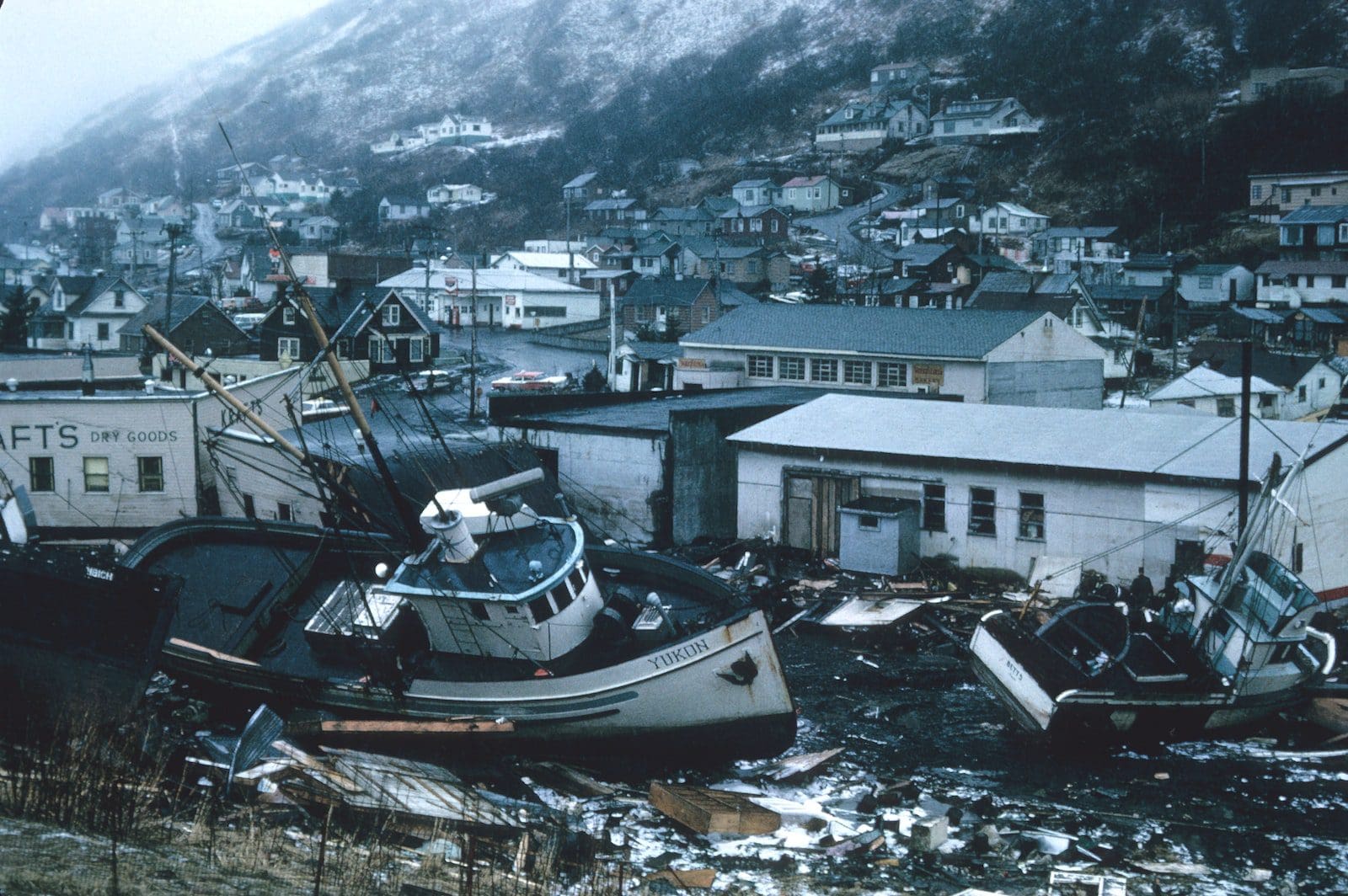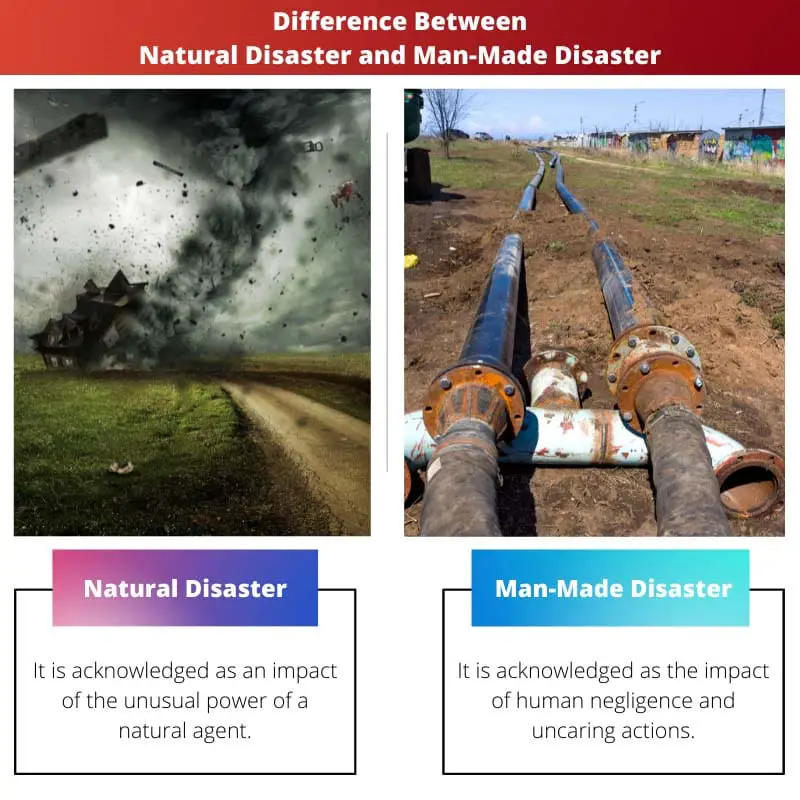The word ‘Disaster’ is extracted from the French term desastre which signifies a ‘Bad or Evil Star.’
A disaster is an unforeseen and catastrophic event that obstructs the functioning of a society causing serious damage to life and property, including the destruction of the economy and environment.
As a result, it outdoes the potential of an affected society or a community to survive using its resources.
There are two types of disasters, namely, ‘Natural Disasters’ and ‘Man-made Disasters.’ The first one is caused by natural forces, and the other one is caused by man himself.
Key Takeaways
- Natural disasters are events caused by natural phenomena such as earthquakes, floods, hurricanes, and wildfires. In contrast, man-made disasters are caused by human activities such as industrial accidents, terrorist attacks, and war.
- Natural disasters are unpredictable and difficult to prevent. In contrast, man-made disasters are the result of human error or negligence and can be prevented through proper planning, safety measures, and risk management.
- Natural disasters can cause widespread damage and loss of life, but man-made disasters can also have devastating consequences for human health, the environment, and the economy.
Natural Disaster vs Man-Made Disaster
Natural disasters are events that are caused by natural phenomena, such as earthquakes, hurricanes, floods, droughts, wildfires, and volcanic eruptions. Man-made disasters are events that are caused by human actions, such as industrial accidents, transportation accidents, nuclear accidents, terrorist attacks, and civil unrest.

Nature is most commonly recognized as the medium of disasters that are known as ‘Natural Disasters’.
Examples of natural disasters are floods, tsunamis, earthquakes, cyclones, forest fires, avalanches, famine, volcanic eruptions, etc. Humans have no control over natural disasters, and they are expected to be uncontrollable.
Humans can be held responsible for some sorts of disasters that are termed ‘Man-made Disasters.’
Disasters like nuclear explosions, train accidents, chemical spills, war, etc., are put under the category of man-made disasters. It is in the hands of humans to prevent man-made disasters by developing a strong disaster recovery plan.
Comparison Table
| Parameters of Comparison | Natural Disaster | Man-Made Disaster |
|---|---|---|
| Definition | It is acknowledged as an impact of the unusual power of a natural agent. | It is acknowledged as the impact of human negligence and uncaring actions. |
| Medium | Natural Forces | Human Error |
| Intensity | Uncontrollable | Can be deterred |
| Interference | Can be influenced by human actions | Can be boosted by natural forces |
| Forewarning | Noticeable natural causes and prior measures can be taken | Obscure origin and no prior measures can be taken |
| Examples of major disaster | Flood, volcanic eruptions, drought, cyclones, avalanches, etc. | Nuclear explosion, war, chemical spills, etc. |
| Examples of minor disaster | Thunderstorms, mud slides, heat waves, cold waves, etc. | Accidents in factories, industrial crisis, road accidents, etc. |
What is Natural Disaster?
A catastrophic event that originates owing to vigorous forces of the natural processes of the earth is called a ‘Natural Disaster.’ There are five types of natural disasters such as
- Geological (tsunami, landslides, earthquakes, etc.)
- Hydrological (floods)
- Climatological (drought, wildfires)
- Meteorological (cyclones, wave surges)
- Biological (epidemics, animal plagues, etc.)
Natural disasters are inevitable, but they arrive with prior notice nowadays, which helps disaster management and the government make arrangements beforehand. Its impact can be minimized by taking pre-emptive measures for the regions which are more prone to it.
Countries with low incomes get excessively affected by natural disasters. Women and children are more susceptible to the after-effects of natural disasters, and millions of immensely poor people are anticipated to survive in the most hazard-prone countries in the coming years.
The influence of these types of hazards takes the form of natural disasters in populated regions.
Considering when a cyclone hits a populated region taking away lives and demolishing abodes, the poor population is expected to be at the edge of losing everything as they lack in resources to start anew.

What is Man-Made Disaster?
A devastating event that occurs due to carelessness or harmful intentions of man is called a ‘Man-made Disaster.’ It is also known as an anthropogenic disaster or human-induced disaster. This kind of disaster is further classified into four main categories, such as
- Societal disaster (terrorism, stampedes, war, etc.)
- Chemical disasters (Industrial accidents, explosions, etc.)
- Transportation disasters (shipwrecks, aeroplane crashes, train accidents, etc.)
- An environmental disaster (global warming, desertification, etc.)
Once man-made disasters come into being, they cannot be stopped from causing serious destruction to nearby or faraway places as it occurs in unexpected regions due to unknown reasons.
These disasters can be avoided by introducing significant measures and smart schemes, taking lessons from previous experience.
Primarily, these kinds of disasters should not take place without little alertness. Usually, they can’t be predicted. Man-made disasters invoke long-lasting effects on human civilization.
For instance, the ill effects of the Atomic Bombings of Hiroshima and Nagasaki Tragedy were prevalent for a good number of years, harming generation after generation.

Main Differences Between Natural Disasters and Man-Made Disasters
- Natural disasters are dominated by natural agents, and disasters owing to irresponsible behaviour or ill-will of humans are called man-made disasters.
- People become adapted to natural disasters accepting the fact that they cannot be controlled. Man-made disasters are hard to foretell but can be deterred with an adequate arrangement.
- Natural disasters are intervened by human civilization taking gigantic forms, for example, recent news of the Monsoon Mayhem in Maharashtra, which is undoubtedly a natural disaster but a result of the construction within the flood lines of the river. On the other hand, man-made disasters are heightened by the involvement of nature’s agents, like biological and chemical threats.
- Natural disasters are intervened by human civilization, taking gigantic form, for example, recent news of Monsoon Mayhem in Maharashtra, which is undoubtedly a natural disaster, but a result of the construction within the flood lines of the river. On the other hand, man-made disasters are heightened by the involvement of nature’s agents, like biological and chemical threats.
- The source of natural disasters is known, but man-made disasters are obscure in most cases.




